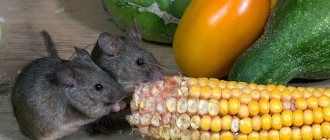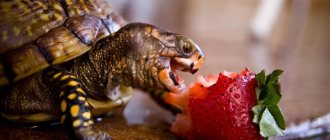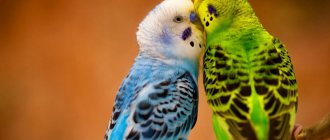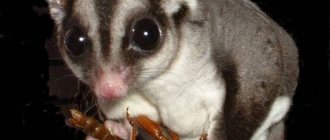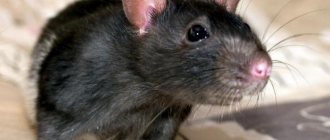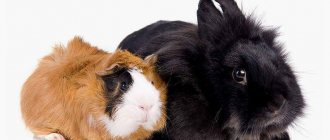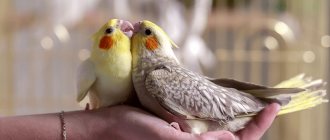Many rodent lovers keep exotic pets at home that look like both jerboas and mice - gerbils. One of the main problems of owners of these animals is proper feeding. And this is not surprising, because its health depends on the animal’s diet. Therefore, we will find out what gerbils eat in the wild, how to properly organize their diet, and what foods should be excluded from the menu.
What do gerbils eat in the wild?
Today, more than 100 species of gerbils are known. These animals are rodents and belong to the mouse-like group. They really look like mice, but are much smaller in size. The animals' slightly elongated hind limbs, as well as the charming tassel on their fluffy tail, give them a resemblance to jerboas. But they do not move in leaps, but in the usual way, like all their close “relatives” - rats, mice and hamsters.
The gerbil has a pointed muzzle, the eyes are large and slightly protruding, and the ears are always in an erect position. The animal is accustomed to warily listening to the world around it.
Over the years of evolution, the fur of rodents has acquired a camouflage coloring; its color varies from brown to yellowish shades, becoming lighter towards the belly and limbs. Some species of animals have light spots near the eyes and ears.
Table 1. Gerbil sizes
| Body length(mm) | Tail length(mm) | Weight (g) |
| 50–200 | 55–245 | 15–230 |
Animals use visual, auditory, chemical and tactile perception of the environment. Pheromones are used to exchange information, which help indicate social and reproductive status. Males mark their territory with a characteristic odor - they use the ventral (sebaceous) glands.
Interesting! Gerbils, like small reptiles, can instantly get rid of their tail in the event of a sudden attack. After this, the animal does not grow a new tail.
Habitat
Gerbils live in India and Africa, China, Mongolia, and central Asia. The animals' favorite habitats are deserts and semi-deserts, savannas, and dry steppes. Some species of these rodents prefer damp forests, mountain valleys, and agricultural lands.
Gerbils are accustomed to living in difficult climatic conditions and have adapted to hot weather. Over the years of evolution, their body has developed a system of protection against dehydration. To reduce fluid loss, as well as reduce the need for water, the gerbils’ body “forgot how” to sweat. This leads to the need to limit the presence of animals in high temperature conditions. Gerbils will survive in the heat of +45°C for no more than 2 hours.
Interesting! Over 30 species of gerbils are listed in the Red Book. Some subspecies of animals have endangered status.
Nutrition
In nature, gerbils feed on the types of plant fiber that are available in the region where they live. Animals use:
- all parts of plants, including tubers;
- seeds;
- fruits of fruit trees that fell to the ground.
In addition to plants, animals catch insects, hunt small reptiles, and do not disdain other rodents. They love to destroy bird nests and eat eggs or chicks. Slugs and snails are a rare delicacy for gerbils that live in dry climates, and almost daily for those living in humid forests.
Interesting! Indian gerbils constantly need fresh food. This forces the animals to settle near forests and wet fields.
Gerbils that live in warm or hot climates eat their food as soon as they find it, before larger predators take the food. Animals from cool regions store food supplies inside large pantries, which they build at a depth of more than 1 m.
Sometimes the weight of food stored by one rodent reaches several tens of kilograms.
Keeping and caring for the Mongolian gerbil
In the photo: Mongolian gerbil
Gerbils can be kept in an aquarium (equipped with a lid and well ventilated) or in a metal cage. These animals are kept in pairs or small families.
The room temperature must be maintained at +20...23 degrees (minimum permissible temperature +15 degrees).
Avoid drafts and direct sunlight.
Gerbils constantly dig, so sprinkle sawdust (not pine!) at the bottom of their “apartment” in a layer of 10 - 15 cm. To build a nest, you will need hay or simple toilet paper. Fabric is a bad choice: the animal can get tangled in the threads.
The drinking bowl is attached outside the cage or inside, but make sure that it does not leak and the sawdust remains dry. If the bedding rots, the gerbils will get sick.
The feeder is suspended above the sawdust level or placed on the second floor of the cage.
Gerbils need to wear down their teeth, so provide them with pieces of wood, twigs, or driftwood. They can be found in nature and disinfected before being given to animals, or purchased at a pet store. If you forget about this, the rodent will begin to grind its teeth on the bars of the cage and may even damage its nose.
These small animals cannot live without sand baths, so place a container of sand in the cage 1-2 times a week. Special sand for rodents is sold at pet stores.
Gerbils need to move a lot, and the cage limits their movement. To prevent kids from suffering, buy a wheel. The plastic “shell” will quickly be destroyed, so it is better to choose a metal wheel equipped with a mesh instead of bars. A wheel with crossbars is dangerous.
Plastic is also not a suitable option for a house: your pets will chew it and get sick. The house must be wooden. The cage is cleaned once every 2 weeks. This includes washing (without using detergents) and changing bedding. With proper gerbil care, there are virtually no unpleasant odors from gerbils.
What to feed your gerbil at home
The bulk of the diet of gerbils that live in the desert consists of grasses and seeds. Domestic rodents can be provided with the same menu. But caring owners, as a rule, add other healthy products to it.
Tamed animals eat with pleasure:
- Combined feed: wheat, oat, barley seeds.
- Feed mixture for parrots.
- Fresh fruit and vegetable supplements.
- Granulated cat food.
- Ready-made food mixture for rodents.
To determine what your animal likes best, it is worth experimenting and offering your pet several food options to choose from. Experts do not recommend feeding gerbils monotonous food, as this can cause them to develop digestive problems.
Feeding a rodent is the best time to establish trusting contact with it. Experienced breeders advise teaching the animal to take food from your hands as early as possible. This way he quickly gets used to the new place and gets used to the owner.
Interesting! Notable are the teeth of gerbils, which are needle-shaped and rooted. Their number ranges from 16–18, with the rear molars (molar crowns) being special. By the tubercles on their surface, researchers determine whether the animals belong to a certain branch of the breed.
How to choose?
First, you need to resolve the issue of the seller. You can buy a gerbil in a specialized store, online via an advertisement, or from professional breeders. The disadvantage of the first option is that pet stores often sell sick animals that were kept in poor conditions.
It also happens that the parents of animals turn out to be related individuals, which is a factor in the development of hereditary diseases in their offspring. It is also very easy to get scammed on the Internet. It is safest to contact professional breeders.
From them you can choose the gerbil you like and get detailed information about the future pet, rules of care and maintenance, as well as information about the behavior characteristics and age of the gerbil.
When buying an animal, first of all, you should pay attention to the appearance of the animal:
Due to the fact that animals love to chew on everything, the bars of the cage should not be made of wood. It is recommended to use a metal cage or a spacious, tightly closed aquarium with good ventilation as a place of residence for the gerbil. The recommended cage size is 40x50 cm.
Build a bedding for housing. The material used is sawdust, hay, paper, as well as a special filler, the thickness of which should be at least 10-15 cm. A thick layer of bedding will allow the animal to dig one or more holes - this activity represents a significant part of their leisure time.
To make your pet's living conditions comfortable, the enclosure should be equipped with a running wheel, walking balls and other entertainment. Thanks to this, the gerbil will not get bored in your absence. In addition, an active lifestyle, even within such a small space, will be very beneficial for the health and well-being of your pet.
Since the animal constantly feels the need to chew something, do not forget to put some branches in the house.
Provide your pet with a sand bath. The animal will regularly clean its skin in it.
Gerbils are unpretentious and therefore quickly and easily get used to home conditions. A significant argument in favor of these animals is the absence of an unpleasant odor, which does not occur even if the enclosure is not cleaned for a long time. It is noteworthy that these rodents are very thrifty - they like to put food, as well as hay and grass in one pile. Keeping these animals is of particular interest also because the animals can live in families, which are very exciting to watch.
Unlike hamsters and chipmunks, gerbils do not hide in corners or seek out dark corners indoors. They are almost always within sight and easily contact people - they readily respond and accept food from their hands.
You should not get gerbils for children under 8-9 years old.
The animals are very mobile and restless, so holding them in your hands and petting them for a long time will not work - the pet will most likely run away.
Natural feeding
All plant foods offered to gerbils must be raw and thoroughly washed. Some of them can be given daily, while others can be given only occasionally as a treat.
Table 2. Permitted products
| You can give | Allowed, but not recommended | Can be given occasionally |
| Pear, apricot, banana, melon, gooseberry, carrot, zucchini, cucumber, corn, broccoli, beets, raspberries, currants, peach, pumpkin, apple, dill, blueberries, persimmon. | White cabbage, radish, sea buckthorn, plum, grapes, Jerusalem artichoke, citrus fruits. | Watermelon, strawberries, pomegranate, tomatoes. |
Interesting! Experienced breeders add a little echinacea (1/3 tsp) to their gerbils' food. This herb maintains the health of rodents and is always eaten with pleasure.
Description
Appearance
In the summer feather
The size of a dunlin, shorter-billed and shorter-legged. The total length is 20-21 cm, the wingspan is 36-39 cm, the weight is 40-60 g. The color of the plumage is almost the same between males and females, but both have seasonal differences. In breeding plumage, the gerbil is similar to the sparrow sandpiper, although noticeably larger. On the head, neck and chest, the red color dominates, diluted with dark streaks. The plumage of the back is more variegated - wide red and buffy edges of feathers are combined with black spots in the middle, sometimes with a white rim along the very edge. The lower part of the chest and belly are white, while, unlike the sparrow sandpiper, a clear boundary between the dark and light areas of the plumage is visible.
In winter, the bird brightens, the red areas of the plumage are replaced by whitish and gray tones. The top is ash-gray with narrow dark above-trunks and narrow whitish edges, the bottom is monotonous white. At winter stops, the gerbil is most easily identified by its special wing pattern: the brownish-gray coverts and secondaries are distinguished by a dark stripe on a sitting bird, clearly visible from a distance. The plumage of juveniles generally shows similarity to the summer plumage of adults, while on the upper side of the body black spots occupy most of the surface of the feather, while the rufous edges are not continuous, but are divided into separate light spots. In addition, the neck and loins of young birds are gray. All birds have black beaks and legs, and brown irises. The hind toe, unlike other sandpipers, is absent.
In recent years, 2 subspecies of this sandpiper have most often been identified - Calidris alba alba
and
Calidris alba rubida
. The first of them nests in northeastern Greenland, on the island of Jan Mayen, Spitsbergen, Franz Josef Land and Taimyr; the second - in Alaska and northern Canada, and also possibly in the Lena Delta and the New Siberian Islands.
Voice
In general, a rather silent bird. When communicating, it makes short, smooth sounds, transmitted as “slab”, “crit”, “kve” or “bale”. The mating song, performed in flight at a height of 2-3 m above the ground, is a melodic trill like “kerrrrr..kerrrrr.” An alarmed bird emits a gurgling “kwe..kwe..kwe”, which at times accelerates, merging into a chirping “querrrrr...”.
Ready-made feed
Today, specialized stores offer a large selection of grain mixtures for domestic rodents. These foods are also suitable for gerbils. Ready-made formulations include grains, healthy herbs, special minerals, and vitamin complexes.
As a rule, the domestic gerbil is offered one or another composition to try. If the animal eats with pleasure, then this food can be used regularly.
There are times when a pet chooses something “tasty” from the proposed mixture and leaves some components of the composition untouched. It should be remembered that the animal did not like it, and in the future do not give the animal such products.
Some gerbils prefer pelleted food. The advantage of such nutrition is optimization of use. The gerbil no longer has the opportunity to choose what to eat and what not, and eats the entire composition.
Features of care - recommendations
- If the weather is very hot, then you can moisten the soil 2 - 3 times a week. Spraying - in drought and heat. Do not allow the root system to dry out.
- When the mountain gerbil is grown in a flowerpot, the amount of watering must be reduced in winter.
- After the flowering period, cut off all faded flowers and dried leaves. Sanitary pruning will keep the bushes in well-groomed condition. And the nutrients will go towards the development and growth of the bush.
- Apply fertilizers only once per season. Complex mineral supplements will be sufficient.
Treats
Animals in captivity are deprived of the opportunity to independently balance their diet. This responsibility falls on the shoulders of the gerbil owners. By nature, fluffy beauties are big gourmands, and without proper control, they can harm their health with excessive or harmful meals.
Gerbils love oily sunflower seeds and a variety of nuts. But it is better to give such treats to animals infrequently, so as not to overload their liver. It is much safer to offer rodents millet sprouts or small seeds that contain oils that are beneficial for their fur.
Literature
- Dementyev G. P., Gladkov N. A.
Birds of the Soviet Union. - Soviet Science, 1951. - T. 3. - 680 p. - Kozlova E. V.
Charadriiformes. Suborder Sandpipers Part 3 // Fauna of the USSR. Birds. - M.-L.: Publishing House of the USSR Academy of Sciences, 1962. - T. 2, issue. 1. - pp. 147-157. — 434 p. — (New episode No. 81). - Ryabitsev V.K.
Birds of the tundra. - Sverdlovsk: Central Ural Book Publishing House, 1986. - 192 p. - Ryabitsev V.K.
Birds of the Urals, the Urals and Western Siberia: A reference guide. - Ekaterinburg: Ural University Publishing House, 2001. - 608 p. — ISBN 5-7525-0825-8. - Stepanyan, L. S.
Abstract of the ornithological fauna of Russia and adjacent territories. - M.: Akademkniga, 2003. - 808 p. — ISBN 5-94628-093-7. - del Hoyo, Josep (Author, Editor);
Elliott, Andrew (Ed); Sargatal, Jordi. Handbook of the Birds of the World. - Lynx Editions, 1996. - T. Volume 3 (Hoatzin to Auks). — 821 p. — ISBN 8487334202. - Delany, Simon;
Dodman, Tim; Stroud, David; Scott, Derek. An Atlas of Wader Populations in Africa and Western Eurasia. - Wetlands International, 2009. - P. 370-375. — ISBN 9058820475. - Marchant, John;
Prater, Tony; Hayman, Peter. Shorebirds: An Identification Guide to the Waders of the World. - Houghton Mifflin Harcourt, 1991. - 400 p. — ISBN 0395602378.
Prohibited Products
If peanuts or sunflower seeds are present in the grain mixture, they should be removed or the feed should not be used. Fats in large quantities are harmful to small pets.
It is better not to include legumes, bean pods, and lettuce leaves in the diet of animals. These products do not contain substances that are beneficial to them.
It is forbidden to feed gerbils potatoes, peppers, radishes, garlic, onions, sorrel, ginger, and avocado.
Important! You can give your pets cherries, but you must first remove the seeds from the berries.
Possible diseases
Gerbils may suffer from the following pathological conditions:
- Cryptosporidiosis (Tizzer's disease) is a disease manifested in circulatory disorders, necrosis of liver tissue and inflammatory processes in the small intestine. The first symptom of the disease is an enlarged abdomen. The disease occurs in an acute form and often ends in death. Young or pregnant animals are most susceptible to Tizzer's disease. The cause of the disease is contaminated food. Prevention consists of periodically cleaning the cage and feeding the pet proven food.
- Epilepsy is a fairly common disease that is inherited. The pathology manifests itself as regular convulsions. Therapy and use of anticonvulsants is not practiced.
- Injuries. Mice often experience injuries to their paws or torn off tails. The best preventive measure is considered to be sensitive care and a properly designed house for your pet.
How to properly care
Pet care should be carried out regularly. Leftover food and trash must be removed every day. The litter is changed several times a week, depending on its condition.
To keep your animal healthy, it is important to keep the feeder and drinking bowl clean. The water must be constantly clean
Water treatments
Due to the fact that these creatures are clean, they are easy to care for. Water procedures should only be carried out if the animal is very dirty, since mice are afraid of water. Before you wet the fur, you need to make sure that this is the only way to clean the animal, and a regular brush will not help.
During water procedures you cannot:
- use shampoos and cosmetics not intended for mice;
- allow water to get into your eyes or ears;
- wash under running water;
- take a lot of water into the bathing bowl;
- talk loudly, as this can cause even more stress for your pet;
- leave the window open and allow a draft in the room where bathing takes place.
Read more about how to determine the gender of a mouse.
Claw treatment
Decorative house mice rarely need to have their claws trimmed. As a rule, they grind them down themselves. But if you see that the animal needs help, it begins to limp, it is difficult for it to move, then in these cases you need help. First you need to carefully examine the paws. If you are convinced that the claws are too long and are in the way of the rodent, they should be trimmed.
For this procedure, it is recommended to use a nail clipper designed for pets (cats, small breeds of dogs). You need to trim very carefully so as not to touch the nail bed and cause pain to your pet. This must be done in such a way as to preserve the natural shape of the claws.
Read with this
- How to toilet train a dog using a diaper
- Can your dog swim? Why Some Dog Breeds Can't Swim - Tips for Pets - 2020
- Reinforcement learning in machine learning
- The hamster is chewing twigs in the cage: what to do?
- How to stop a dog from biting
- Everything you need to know about caring for budgies at home
- How to pet a cat correctly
- Operant method of dog training
- Without unnecessary noise
- Why cats love boxes and bags
Choosing a pet
You have bought everything you need for care, allocated a place for your new pet, and now it’s time to move on to the most important thing - choosing the animal itself. First, let's take a look at the breeds
There are already more than 110 species of gerbils; we will focus on the most popular.
Gerbil breeds
Mongolian, also known as clawed. The most common inhabitant of houses and apartments. The color of the coat is from coal black to snowy white - the breeders took care of diversity. There are even bluish shades. It grows up to 20 cm in length, weighs about 120 g. There is often a small tassel at the end of the tail.
Color options for the “Mongols” can be seen in the video below. But please ignore the advice that it is better to feed the rodent more often with sweets and tropical fruits.
Fluffy-tailed. This species is captivating with its chic tassel on the tail. In stores you usually only find the sand color. Length 10-13 cm.
Fluffy-tailed. This is a tail you can be proud of!
Short-eared. Red or brownish, white belly. Grows up to 12 cm.
Short-eared, but very cute.
Cheeseman's gerbil grows up to 11 cm, with a long tail. The most interesting feature is the huge (relative to the head) eyes.
You can drown in such eyes... Cheeseman's gerbil.
Persian. Quite a large individual (can grow up to 20 cm and gain weight of 170 g). Has a beautiful tassel at the end of the tail.
Persian beauty.
Let's go buy
Where to buy animals - from breeders or in a store - is everyone’s personal choice. We do not agree with the opinion that stores provide poor care and often sneak in already sick animals. Choose a store that is trusted (fortunately, reviews can be found on the Internet without any problems). In a good store and good care. At the same time, we met with private breeders who kept their pets in terrible conditions and tried to sell old gerbils or the wrong sex
Therefore, it doesn’t matter where to buy, but make preliminary inquiries about the seller
Below are the main points to pay attention to when purchasing
- If you are going to take pets of different sexes, it is advisable that they be from different parents (to reduce the risk of genetic diseases).
- It is better to take same-sex dogs from the same litter so that they are already accustomed to each other.
- It's great if you can look at your parents. It will be immediately obvious whether they are active or lethargic, friendly or aggressive. Offspring are likely to inherit character traits.
- The best age to buy is 6-9 weeks. If you have no experience, it is difficult to determine age. Bring experienced gerbil keepers with you if possible. If not, rely on reliable sellers.
- Eyes, ears, nose should be free of discharge and inflammation.
- The coat should be smooth, clean and not matted anywhere (feel free to look under the tail).
- There should be no scratches, wounds or rashes on the skin.
- Listen to your breathing, usually if there is wheezing, you can hear it.
- A healthy gerbil is active and inquisitive, but if the animal is lethargic and does not respond to you, then it may be sick.
We are already waiting for new owners :)
Determining gender
Determining sex at such an early age (6-9 weeks, as we recommend for purchase) is difficult, but there are still signs.
If the age is closer to the upper limit, then in males, when you lightly press on the belly, the testes (testicles) protrude. By the way, this is one of the ways to check age, because... They will not perform for very young boys.
Another way. The distance between the anus and the genitals in females is much smaller, literally millimeters. Males have much more.
Social behavior
The midday gerbil is active: in spring and summer in the evening and at night; in autumn during the fodder harvesting period and in winter - around the clock. She does not move far from the burrows and tries to feed under the cover of bushes. Gerbil burrows are usually located under the roots of bushes, on hills. There are feeding, spring-summer (temporary) and wintering (permanent) burrows. The latter have the most complex structure: their depth is 80-200 cm, length up to 4 m, there are several storerooms and 1-2 living chambers. From 5 to 15 gerbils spend the winter in such a hole. Simpler burrows serve as daytime or temporary shelters; There can be from 1 to 4 of them in a family plot. Midday gerbils are colonial, especially during the breeding season and winter. They feed mainly on seeds; and also in small quantities by insects. In September-October, gerbils make reserves for the winter, the weight of which can reach 300-500 g (no more than 2 kg). The reserves are eaten by animals wintering in the same hole under particularly unfavorable weather conditions.
Spreading
The habitat is located in Northern Sahara. The fat-tailed gerbil lives in Libya, Tunisia, Algeria and northwestern Egypt.
The rodent inhabits sandy layers with sparse vegetation located in rocky areas of the desert. It strictly avoids the more fertile coastal deserts of the Mediterranean.
In Libya it is also common in the transitional deserts that run roughly parallel to the coastal plains. Its population density is extremely uneven. In Egypt, its range overlaps with that of the Sundevalla gerbil (Meriones crassus) and pygmy gerbils (Gerbillus).
Rodent character
Speaking about the character of this mammal, it is worth highlighting its friendliness and curiosity. The gerbil is always the first to make contact with a person. It is not at all difficult to tame a rodent, since it is initially almost tame.
Treat this beautiful creature with treats from your hands several times, and it will become your loyal friend. If you don't do anything threatening to your gerbil, it will never bite you. Thanks to such loyalty, the gerbil has won the hearts of rodent lovers around the world.
As for the interaction of this mouse with other animals, it will never be the first to show hostility. If discord arises, she would rather retreat than take part in the conflict.
Plus, the gerbil is a very energetic animal. The phases of its activity are not related to the time of day, they simply repeat periodically with short rest breaks. However, if you try to change your pet's daily routine to suit your daily routine and move him to a dark room at night, it is quite possible that he will sleep until the morning.
Training and games
Gerbils are very playful rodents.
Gerbils are very curious animals. It’s worth building communication with a new pet and training it on this feature.
Before you begin to master joint games with the animal, you should accustom it to your hands. To do this, offer the rodent various treats. Sooner or later he will come closer and stop being afraid. Do not make sudden movements - this may frighten the animal.
Gerbils enjoy playing with humans. They love to run along hands, climb into sleeves and make their way through a kind of tunnel. With frequent communication, mice get used to the owner and independently climb onto his shoulder, from where they enjoy watching everything that happens. During the games, you can periodically feed your friend.
Do not frighten or scold the mammal under any circumstances; in response to this, it may bite or stop approaching the person.
Reproduction
In flight
It appears in breeding areas at the end of May or beginning of June, when the first thawed patches appear in the tundra. At first it stays on the sea coast, then moves to drier, elevated rocky areas, covered only with lichens and individual bushes of creeping plants - willow, partridge grass, saxifrage, usually at an altitude of no more than 200 m above sea level. In Greenland it nests on rocky plateaus up to 800 m above sea level, sometimes at a considerable distance from the coast.
Reproduction itself is preceded by the mating season, during which the males display - they rise low into the air and fly from one thawed patch with hoarse cries, alternating between gliding and fluttering flight. The male’s favorite posture on the ground—slightly lowered wings, a fanned tail, and ruffled feathers—is demonstrated from the height of a rock or hummock in order to attract a passing female. The type of reproduction varies: in some populations both monogamy and sequential polyandry are recorded.
Eggs are laid in mid-June or later if the tundra is not yet free of snow at this time. The nest is a flat depression on bare ground or in moss and lichen, lined with several dry plant stems and pieces of moss. The clutch usually contains 4, less often 3, yellowish-olive eggs with brown and brown spots (more numerous closer to the blunt end of the egg). Egg sizes: (33.0-38.2) - (23.5-26.2) mm. Both parents incubate for 23-24 days.
When danger appears, the sitting bird leaves the nest and tries to ward off the predator from a great distance, diverting its attention to itself with screams and demonstrative behavior of the “wounded bird.” Both members of the pair also lead and warm the brood, but the distribution of their roles is still considered insufficiently studied
At the age of about two weeks, the chicks become completely independent, after which the broods quickly disintegrate. Autumn migration from late July to mid-September; adult birds are the first to leave.
